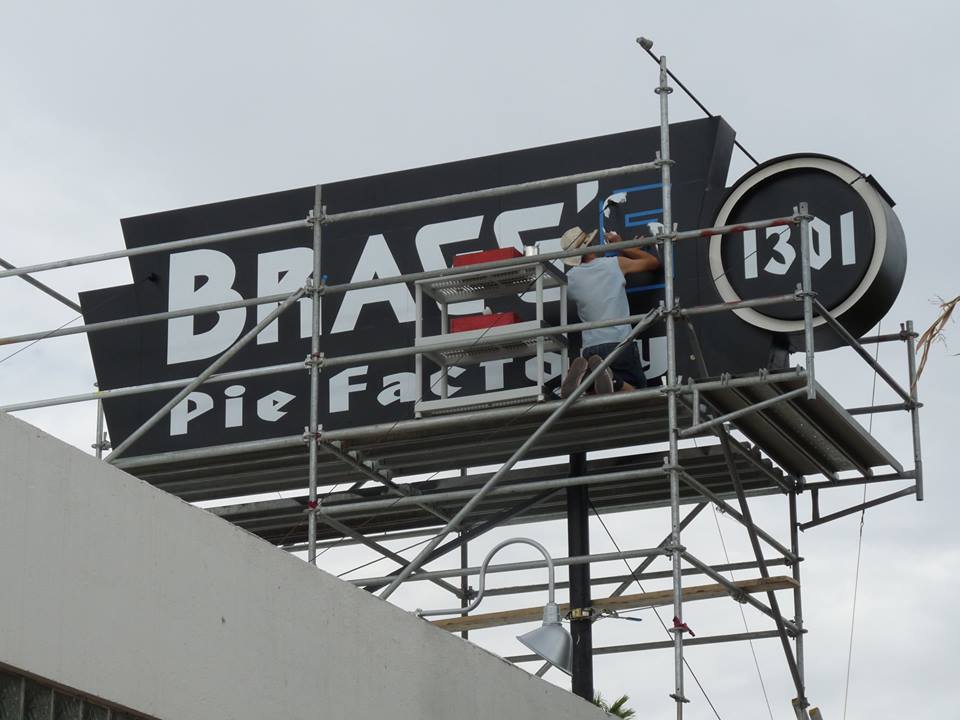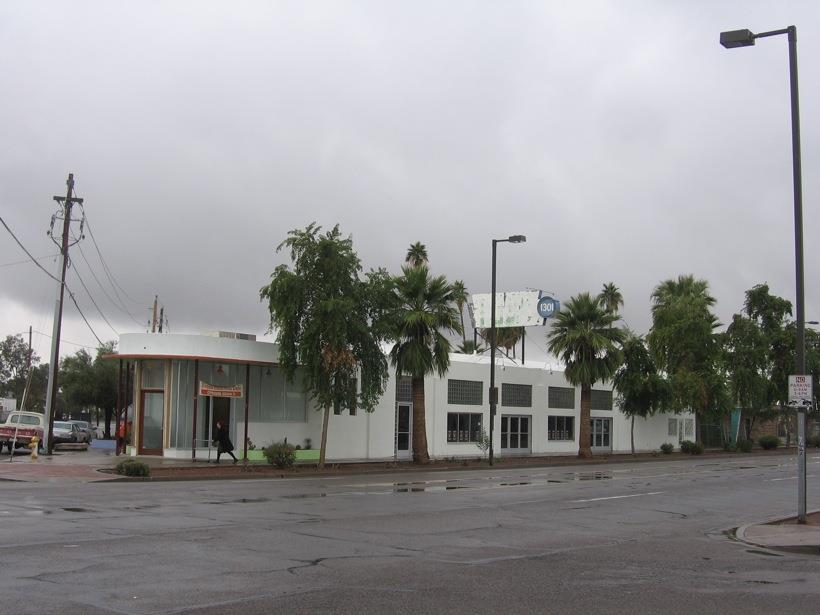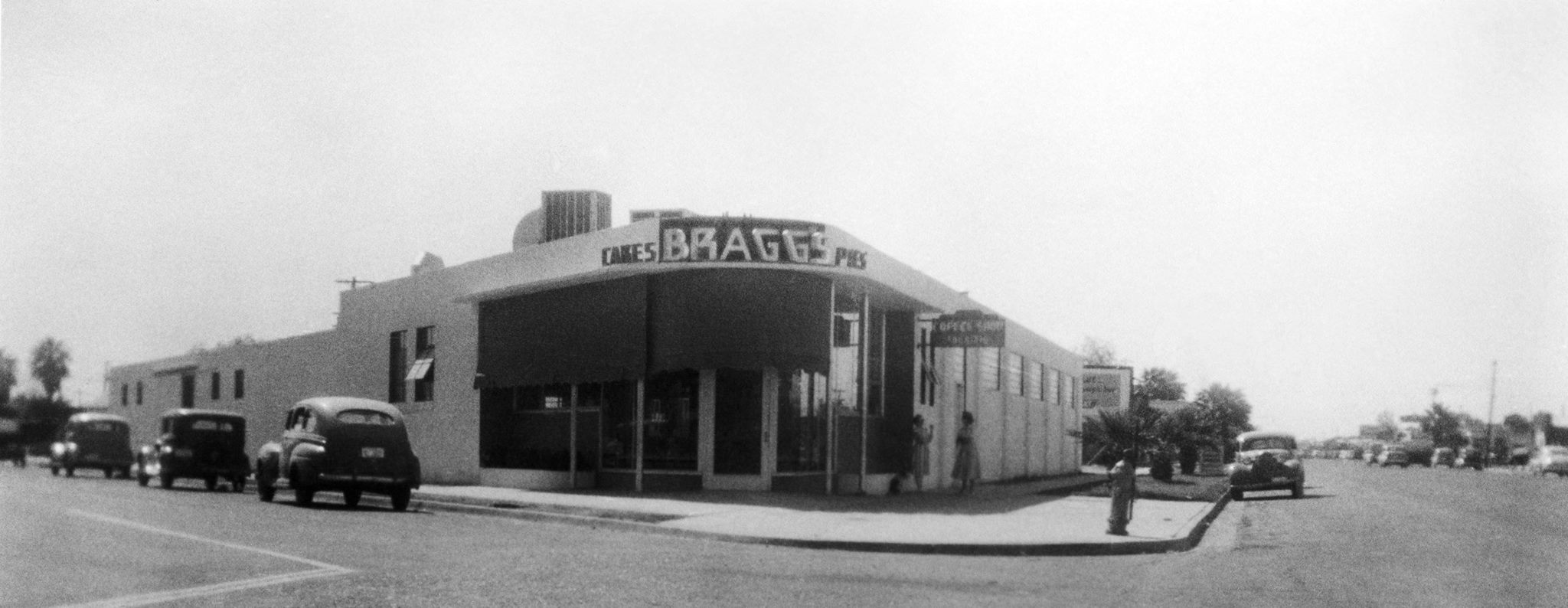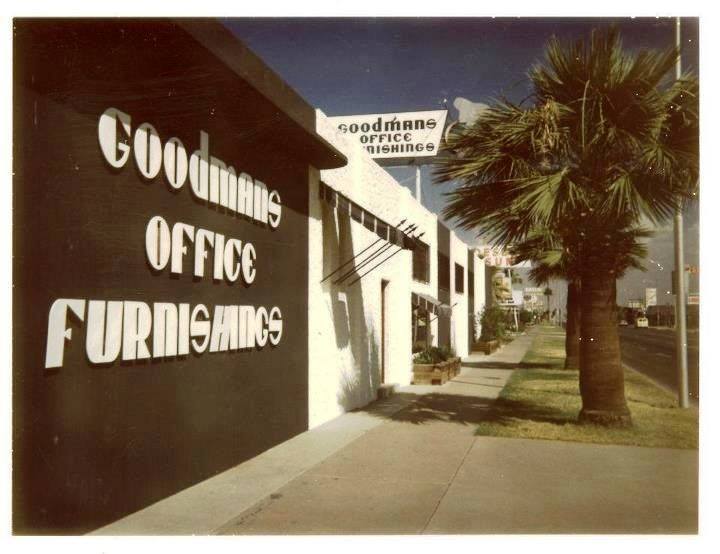History
Braggs Pie Factory
We bought the Bragg's Pie Factory building in 2004. We had originally tried to purchase it 4 years prior to that, but the owner at the time (a real estate investment firm) would not come down enough and we would not go up enough in our offer. We did notice, when we toured it with the realtor, that one of the drop down ceiling tiles was missing, and that it had an amazing bow truss roof structure hidden by the ceiling. When we did not get it, and it was purchased by Michael Goodwin, a local architect, we were actually relieved as we started thinking it was too big of a project for us (most of our renovations had been quite a bit smaller than this at that time). In 2004, Michael Goodwin put the property on the market and because of the derelict state of the Desert Sun Motel next door, we started seeing what we thought were speculators circulating the block (we had learned by then that developers love having the whole block as they want everything to have a similar look). We were certain any developer or speculator would demolish the pie factory, so we decided to make another offer for it. After purchasing the building in 2004, we ran into plenty of snags (including one that triggered a change of use; anyone who has done adaptive re-use knows that is NOT something you want to hear) and it took both a financial and emotional toll. There was a tenant in the building when we were in escrow and they moved out in the middle of the night and left their floor to ceiling stuff behind, even their office equipment. We had planned to consolidate them and keep them as tenants to help pay the mortgage so were unprepared for a completely empty buidling. Thank goodness Michael Goodwin hired his nephew and a friend (who were on summer break) to clean out all the stuff; probably 30 big construction dumpsters full. It took us 4 years to complete the project and get it listed on the National Register of Historic Places - and we finished just as the downturn hit in 2008.
THE FIRE - Within the first year of owning the building, there was a terrible fire right next door at the Desert Sun Motel, which had devolved into a full scale flop house. A couple from California had purchased it when it was still a functioning Motel with a restaurant. However, they had absolutely no idea what they were doing, and soon it was full of drug dealers and petty criminals. They finally sold it to a speculator who was just as clueless, and he soon evicted everyone and fired the workers - tossing everyone out onto the street. We had all been worried for quite some time that a tragic fate awaited the motel, because of lack of oversight and inexperience with the problems in the neighborhood. Within a couple of weeks someone set the middle motel building on fire (we suspect arson, and have heard rumors it was the former maintenance man). The middle 2-story motel buidling burned and was eventually demolished. We live 2 blocks down the street on Grand, and I was in the habit of looking out whenever I heard fire trucks or ambulances, if they sounded at all close, to see where they were headed. I heard a bunch of fire engines that night around 10 or 11 but for some reason (tiredness maybe) I did not look out to see where they were going. So we had no idea a building in close proximity to the pie factory was in flames - until a neighbor called me about 4 in the morning, and by then the fire was mostly out but still smoldering. We raced down the street and found it flooded with water and fire retardant, and were told by one of the fire fighters later, that he actually damaged his lungs trying to keep the fire from jumping to our roof. If our roof had burned it would have been irreplaceable so I still thank those firefighters for the job they did that night. Fausto Fernandez, who was living in the residential apartment above The Lodge across the street, took these photos during and after the fire.
STATEMENT BY CURRENT BRAGG'S PIE FACTORY CO-OWNERS BEATRICE MOORE AND TONY ZAHN (updated 10/10/15):
When we first moved to Phoenix in 1986, we moved to a bungalow at 15th Avenue and Fillmore in the Oakland Historic District, attracted to the lively, multi-cultural feel of the area and the sweet, small family homes. After a year of homey domesticity, we were eventually attracted to the warehouse district (south of downtown), with its blocks of interesting commercial building stock, and affordable studio space. We moved to the historic La Amapola Bar in 1988, which we renovated, and where the first Art Detour was planned and executed in 1989.
After being relocated for the Sun's Arena in 1990, real estate prices began to escalate in the warehouse district with new projects coming on line - like the Arizona Center and Bank One Ballpark. We decided if we wanted to purchase property we would have to look elsewhere, and liked the quirky architecture, substantial stretch of small vintage buildings, and the industrial feel of Grand Avenue. We purchased our first live/work space at Grand and Fillmore in 1992, actually moving there from our warehouse at 5th Avenue and Jackson in 1994.
And although living in a neighborhood with typical inner city problems such as crack houses, gangs, graffiti and the like has been challenging, the neighborhood has never lost its genuine appeal due to the many interesting vintage buildings that create a gritty boulevard, connecting the edge of downtown with points west. The array of characters that populate the streets and homes make this neighborhood a real place for real people, and vibrant and original as a result.
Over the last 23 years we have purchased and renovated several vintage buildings along the street, in some cases creating some whimsical facades of our own in the process, and have been able to provide affordable rents for artists and arts related businesses. These types of adaptive re-use projects and distinctive districts are seen as valuable economic development tools to most successful cities. As Phoenix sprawls into the desert, creating waves of look-alike housing and generic shopping districts, these distinct areas should be viewed as little gems in an increasingly generic environment.
Bragg's Pies, one of the last remaining examples of "streamline moderne" architecture in the city, originally opened in 1947 and at the peak of its operations was a state-of-the-art facility that had 35 daily routes that reached as far as Tucson and Yuma. Located on "Lower Grand", which stretched from Grand Avenue's terminus at Seventh Avenue and Van Buren ("Five Points") to the old city/county line at Nineteenth Avenue and McDowell ("Six Points"), the district served as a zone for transportation-related retail (service stations, restaurants, motels, etc.), transient worker housing and industrial/commercial uses.
When Allan and Elaine Bragg purchased the northwest corner of Grand Avenue and McKinley Street in 1945 it was a vacant lot. They had managed or owned several small pie bakeries in the area for ten years and the vacant site was a good fit for a business that had outgrown its smaller quarters on Van Buren, just north of the State Capitol. The new facility combined manufacturing, delivery and walk-up sales. Lower Grand was, at the time, part of US Route 60 and Phoenix' major transportation corridor to points west.
Conceived as an elegant boulevard lined by 1000 ash trees and the villas of Phoenix' wealthy by pioneer developer W. J. Murphy in 1887, Grand Avenue instead evolved into a gritty commercial district. In the 1930s, "tourist courts", proto-motels catering to long distance travelers and migrant laborers began to appear, clustering toward the Six Points end of Lower Grand. Trolleys ran up and down Grand Avenue until the late 1940s and one could catch a train to points west at 19th Avenue.
Lower Grand's greatest commercial prominence was in the 1950's with more than 120 businesses lining the 13 blocks, including a Chevrolet dealership, a Safeway store and a department store and bank at Six Points. Transportation related businesses continued to dominate the mix - several new, resort style motor-hotels or "motels" made their appearance mid-decade. One of the finest examples, the 3.9 acre Hotel Desert Sun, was built adjacent to the Braggs' Pies Building in 1955.
Combined with the national trend toward flight to the suburbs, two events were major contributors to the slump that eventually occurred in the district: the opening of Interstate 10 that circumvented downtown in 1978, diverting traffic from U.S. 60 and Grand Avenue; and the abrupt removal of curb-side parking in 1980, crippling retail businesses. Ownership of Bragg's Pies passed to several baking operations, before being converted to Goodman's Office Supply in the early 1960's. The building began to slowly reflect a sense of decay in the 1970's as it transitioned into various uses over the next 30 years, divided up piecemeal to suit constantly changing owners and needs.
Ownership of the building eventually passed to real estate investors with the real potential for demolition. After an unsuccessful attempt to purchase the building in 2000, we eventually purchased the building in 2004 when it was once again listed for sale, and applied for a grant from the City of Phoenix Historic Preservation Office to assist with exterior improvements, like windows, a foam roof, additional entry doors, and to create ADA accessibility. The building was later added to the National Register of Historic Places.
Meanwhile, the surrounding area is undergoing a gradual renaissance, sparked by the involvement of the arts community, renovation of many of the historic structures, and new entrepreneurial businesses attracted to the eclectic street and interesting architecture. These new businesses coexist nicely with long-time businesses, creating an interesting mix of the old and the new - and helping to preserve the authentic character of the district and the feeling of a genuine neighborhood. 24 hour curbside parking, recently restored to the stretch between Van Buren and Roosevelt, has helped bring the neighborhood full circle.
Beatrice Moore & Tony Zahn








